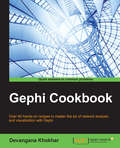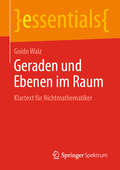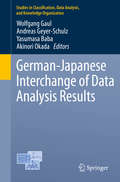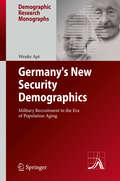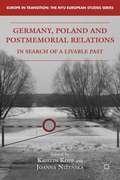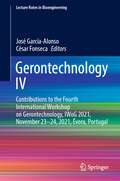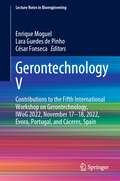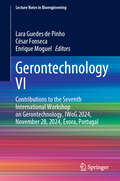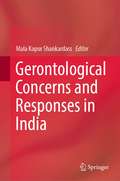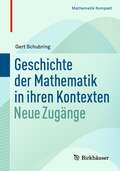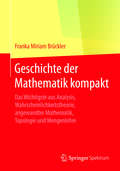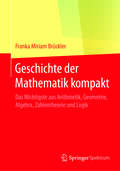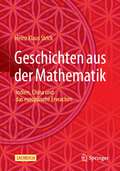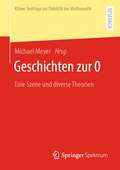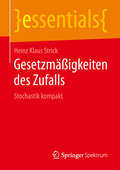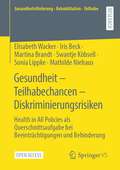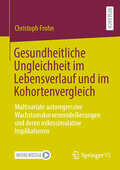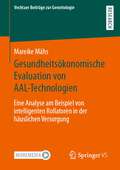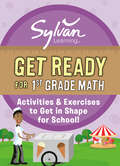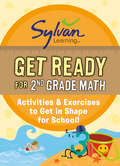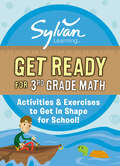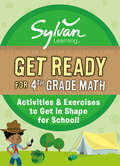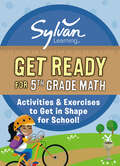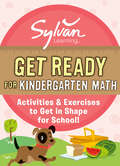- Table View
- List View
Gephi Cookbook
by Devangana KhokharIf you want to learn network analysis and visualization along with graph concepts from scratch, then this book is for you. This is ideal for those of you with little or no understanding of Gephi and this domain, but will also be beneficial for those interested in expanding their knowledge and experience.
Geraden und Ebenen im Raum: Klartext für Nichtmathematiker (essentials)
by Guido WalzDieses essential vermittelt in leicht zugänglicher Sprache Wissenswertes über Geraden und Ebenen im Raum, inklusive der notwendigen Grundlagen der Vektorrechnung. Das erste Kapitel behandelt zunächst die für das weitere Verständnis notwendigen Teile der Vektorrechnung, dies sowohl graphisch als auch mithilfe der Koordinatendarstellung von Vektoren. In Kapitel 2 werden dann verschiedene Arten der Darstellung von Geraden und Ebenen im Raum vorgestellt und Verfahren zu ihrer Bestimmung dargelegt. Das abschließende dritte Kapitel ist Methoden zur Berechnung von Schnitten zwischen einer Geraden und einer Ebene sowie zwischen Geraden und Ebenen untereinander gewidmet. Zahlreiche Beispiele machen die behandelten Themen leicht verständlich.
German-Japanese Interchange of Data Analysis Results
by Akinori Okada Wolfgang Gaul Andreas Geyer-Schulz Yasumasa BabaThis volume focuses on innovative approaches and recent developments in clustering, analysis of data and models, and applications: The first part of the book covers a broad range of innovations in the area of clustering, from algorithmic innovations for graph clustering to new visualization and evaluation techniques. The second part addresses new developments in data and decision analysis (conjoint analysis, non-additive utility functions, analysis of asymmetric relationships, and regularization techniques). The third part is devoted to the application of innovative data analysis methods in the life-sciences, the social sciences and in engineering. All contributions in this volume are revised and extended versions of selected papers presented in the German/Japanese Workshops at Karlsruhe (2010) and Kyoto (2012).
Germany's New Security Demographics
by Wenke AptMilitary recruitment will become more difficult in times of demographic aging. The question arises whether demographic change will constrain the capacity of aging states like Germany to conduct foreign policy and pursue their national security interests. Since contemporary military operations still display a strong human element, particular scrutiny is given to the empirical analysis of the determinants of military propensity and military service among youth. An additional human capital projection until 2030 illustrates how the decline in the youth population will interact with trends in educational attainment and adolescent health to further complicate military recruitment in the future. A concluding review of recruiting practices in other NATO countries provides insight in best-practice policy options to reduce the military's sensitivity to demographic change. Following this approach, the book gives prominence to a topic that has thus far been under-represented in the greater discussion of demographic change today, namely the demographic impact on international affairs and strategic calculations.
Germany, Poland, and Postmemorial Relations
by Kristin Kopp Joanna NiżyńskaCovering the period following the collapse of communism, the unification of Germany, and Poland's accession to the EU, this collection focuses on the interdependencies of German, Polish, and Jewish collective memories and their dialogic, transnational character, showing the collective nature of postmemory and the pressures that shape it.
Gerontechnology IV: Contributions to the Fourth International Workshop on Gerontechnology, IWoG 2021, November 23–24, 2021, Évora, Portugal (Lecture Notes in Bioengineering)
by José García-Alonso César FonsecaThis book gathers peer-review contributions to the 4th International Workshop on Gerontechnology, IWoG 2021, held on November 23-24, 2021, in Évora, Portugal. They report on cutting-edge technologies and optimized workflows for promoting active aging and assisting elderly people at home, as well as in healthcare centers. They discuss the main challenges in the development, use and delivery of health care services and technologies. Not only they propose solutions for improving in practice the monitoring and management of health parameters and age-related diseases, yet they also describe improved approaches for helping seniors in their daily tasks and facilitating their communication and integration with assistive technologies, thus improving their quality of life, as well as their social integration. All in all, this book provides health professionals, researchers, and service providers with extensive information on the latest trends in the development and practical application of gerontechnology, with a special emphasis on improving quality of life of the elderly.
Gerontechnology V: Contributions to the Fifth International Workshop on Gerontechnology, IWoG 2022, November 17–18, 2022, Évora, Portugal, and Cáceres, Spain (Lecture Notes in Bioengineering)
by César Fonseca Enrique Moguel Lara Guedes de PinhoThis book gathers peer-review contributions to the 5th International Workshop on Gerontechnology, IWoG 2022, held on November 17-18, 2022, in Évora, Portugal, and in Caceres, Spain. They report on cutting-edge technologies and optimized workflows for promoting active aging and assisting older adults at home, as well as in healthcare centers. They discuss the main challenges in the development, use and delivery of health care services and technologies. Besides proposing solutions for improving monitoring and management of health parameters and age-related diseases, the chapters also describe approaches for helping seniors in their daily tasks and facilitating their communication and integration with assistive technologies. All in all, this book provides health professionals, researchers, and service providers with extensive information on the latest trends in the development and application of gerontechnology, with a special emphasis on improving quality of life and social integration of the elderly.
Gerontechnology VI: Contributions to the Seventh International Workshop on Gerontechnology, IWoG 2024, November 28, 2024, Évora, Portugal (Lecture Notes in Bioengineering)
by César Fonseca Enrique Moguel Lara Guedes de PinhoThis book gathers peer-review contributions to the 7th International Workshop on Gerontechnology, IWoG 2024, held on November 28, 2024, in Évora, Portugal. They report on cutting-edge technologies and optimized workflows for promoting active aging and assisting older adults at home, as well as in healthcare centers. They discuss the main challenges in the development, use and delivery of health care services and technologies. Besides proposing solutions for improving monitoring and management of health parameters and age-related diseases, the chapters also describe approaches for helping seniors in their daily tasks and facilitating their communication and integration with assistive technologies. All in all, this book provides health professionals, researchers, and service providers with extensive information on the latest trends in the development and application of gerontechnology, with a special emphasis on improving quality of life and social integration of the elderly.
Gerontological Concerns and Responses in India
by Mala Kapur ShankardassThis book discusses gerontological issues and challenges impacting the quality of life of older people in India. The chapters provide different disciplinary insights ranging from sociology, anthropology, psychology, health sciences, social work, demography, gender, and legal perspectives. The chapters are written by experts and practitioners in the field bringing focus to new gerontological insights from an academic and an empirical perspective. It engages the reader with the growth of different branches of gerontology along with concerns faced by older people. It brings attention to concerns related to ageing of the population in different parts of the country, such as among the tribes, the LGBT community, and conflict zones. It highlights gender aspects related to health care and discusses policy responses, strategies to empower older persons, the role of voluntary organizations, issues related to caregiving and family bonding, and aspects of social protection for the older people. It offers a valuable resource for researchers, academics, practitioners, and policymakers in the areas of gerontology, demography, and sociology, as well as all those interested in the study of ageing populations.
Geschichte der Mathematik in ihren Kontexten: Neue Zugänge (Mathematik Kompakt)
by Gert SchubringDieses Buch ist konzipiert für angehende und praktizierende Mathematiklehrer; es richtet sich aber auch generell an Studierende der Mathematik. Ebenso wird es einem an Mathematik interessierten Leser neue Zugänge zur Mathematik eröffnen.Kenntnisse in Geschichte der Mathematik werden stets wichtiger als Bestandteil der Mathematiklehrer-Ausbildung: zur Vertiefung des Begriffs-Verständnisses und aufgrund der in der Mathematik-Didaktik international stets stärker empfohlenen Einbeziehung der Mathematik-Geschichte in den Mathematikunterricht – um durch die Vorzüge einer „genetischen“ Methodik die Begriffsentwicklung bei den Schülern effektiver gestalten zu können. Das Buch will zur Ausbildung von „Metawissen“ beitragen – von Wissen über das Fachwissen. Anstatt der häufigen Reduktion der Mathematik-Geschichte in Lehrbüchern auf anekdotische Informationen oder der Beschränkung auf wenige, als ‚große‘ präsentierte Mathematiker und auf ideengeschichtliche Entwicklungen eröffnet das Buch, auf dem aktuellen Stand der historischen Forschung, neue Zugänge zum Verständnis der Begriffs-Entwicklungen durch deren Darstellung in ihren kulturellen und sozialen Kontexten. Zudem leitet das Buch dazu an, traditionelle historische Berichte aufgrund neuerer Methodologien kritisch zu hinterfragen.Den meisten Kapiteln sind Aufgaben hinzugefügt, teils zur Vertiefung der Themen des Kapitels, teils als Anregung zur eigenen Praxis, um sie etwa selbst im Unterricht einzusetzen.
Geschichte der Mathematik kompakt: Das Wichtigste aus Analysis, Wahrscheinlichkeitstheorie, angewandter Mathematik, Topologie und Mengenlehre
by Franka Miriam BrücklerDieses Buch gibt einen kompakten Überblick über die historische Entwicklung und Ideengeschichte derjenigen mathematischen Gebiete, die sich erst in der Neuzeit zu eigenständigen Teildisziplinen entwickelt haben: Analysis, Wahrscheinlichkeitstheorie, angewandte Mathematik, Topologie und Mengenlehre. Die Darstellung verzichtet auf Vollständigkeit und konzentriert sich stattdessen ganz bewusst auf wesentliche oder besonders interessante Aspekte: Einzelne Persönlichkeiten und Ideen werden exemplarisch herausgegriffen und detaillierter dargestellt als andere – es entsteht jedoch insgesamt ein stimmiges, ausgewogenes und dennoch übersichtliches Gesamtbild. Dabei wird insbesondere begreifbar, dass die historische Entwicklung der Mathematik von zahlreichen Einflüssen angetrieben wurde, dass zahlreiche theoretische Resultate aus ganz praktischen Gründen gefunden wurden (und umgekehrt), und dass es zu den wenigsten mathematischen Problemen nur einen (richtigen) Lösungsweg gibt. Auch Querverbindungen zwischen den verschiedenen Disziplinen werden deutlich. Das Buch wendet sich an all jene, die eine übersichtliche, kurze Darstellung der zentralen Momente in der Geschichte der Mathematik suchen – vor allem Professoren, (zukünftige) Lehrer und Studierende.
Geschichte der Mathematik kompakt: Das Wichtigste aus Arithmetik, Geometrie, Algebra, Zahlentheorie und Logik
by Franka Miriam BrücklerDieses Buch gibt einen kompakten Überblick über die historische Entwicklung und Ideengeschichte derjenigen mathematischen Disziplinen, die sich schon bis zur Renaissancezeit weitgehend eigenständig entwickelt haben: Arithmetik, Geometrie, Algebra, Zahlentheorie und mathematische Logik. Die Darstellung verzichtet auf Vollständigkeit und konzentriert sich stattdessen ganz bewusst auf wesentliche oder besonders interessante Aspekte: Einzelne Persönlichkeiten und Ideen exemplarisch herausgegriffen und detaillierter dargestellt als andere – es entsteht jedoch insgesamt ein stimmiges, ausgewogenes und dennoch übersichtliches Gesamtbild. Dabei wird insbesondere begreifbar, dass die historische Entwicklung der Mathematik von zahlreichen Einflüssen angetrieben wurde, dass zahlreiche theoretische Resultate aus ganz praktischen Gründen gefunden wurden (und umgekehrt), und dass es zu den wenigsten mathematischen Problemen nur einen (richtigen) Lösungsweg gibt. Auch Querverbindungen zwischen den verschiedenen Disziplinen werden deutlich. Das Buch wendet sich an all jene, die eine übersichtliche, kurze Darstellung der zentralen Momente in der Geschichte der Mathematik suchen – vor allem Professoren, (zukünftige) Lehrer und Studierende.
Geschichten aus der Mathematik: Indien, China und das europäische Erwachen
by Heinz Klaus StrickUnser heutiges Bild von Mathematik ist geprägt von der Entwicklung des Fachs auf unserem europäischen Kontinent. Andere Kulturen spielten und spielen in unserem Bewusstsein kaum eine Rolle. Welchen Austausch von mathematischem Wissen gab es – schon im Altertum und seit Beginn der Neuzeit – etwa mit den Wissenschaftlern des indischen Subkontinents? Oder gar mit den chinesischen Mathematikern? Die Quellenlage ist unsicher – doch bereits im alten China wurde eine Fülle von Schreibweisen und Techniken entwickelt, die erst sehr viel später auch in Indien und in Europa bekannt und genutzt wurden. Dieses Buch zeigt, welch erstaunliche Vielfalt an mathematischen Ideen außerhalb Europas entwickelt wurde und wie dann schließlich auch in Europa die Mathematik aus dem mittelalterlichen Schlaf erwachte. Es enthält eine Reihe von Lebensgeschichten von Mathematikern aus den genannten Kulturen sowie Erläuterungen der mathematischen Probleme und Theorien, mit denen sie sich beschäftigt und für die sie Lösungswege gefunden haben. Den Anfang des Buches bildet der (gescheiterte) Versuch europäischer Missionare, die Chinesen mithilfe der klassischen „europäischen“ Mathematik von der Überlegenheit der europäischen Kultur zu überzeugen...
Geschichten zur 0: Eine Szene und diverse Theorien (Kölner Beiträge zur Didaktik der Mathematik)
by Michael MeyerDie Grundlage dieses Buches bildet ein Interview mit einer Erstklässlerin zur Zahl Null. Dieses wurde mit verschiedenen theoretischen Perspektiven unter Nutzung einer interpretativen Methode analysiert. Die Perspektiven entstammen der Mathematik, ihrer Didaktik sowie diverser Bezugsdisziplinen (u. a. Germanistik, Naturwissenschaftsdidaktik, Philosophie und Soziologie). Ziel der Analysen (der Geschichten) ist die interaktionistische Rekonstruktion des Gespräches: Was erlaubt die jeweilige Theorie zu erfassen? Anschließend werden die Analysen verglichen, um Spezifika und den Mehrwert herauszustellen.
Geschlechterunterschiede bei Depressionen im Alter: Risikofaktoren und Bewältigungsressourcen im europäischen Vergleich (Dortmunder Beiträge zur Sozialforschung)
by Alina SchmitzGeschlechterungleichheiten bei Depressionen wurden in zahlreichen Studien dokumentiert. Die Lebensphase Alter findet in der bisherigen Forschung allerdings wenig Beachtung. Diese Studie verfolgt auf Basis des Survey of Health, Ageing and Retirement in Europe (SHARE) folgende Fragen: Wie verbreitet sind depressive Symptome in der älteren Bevölkerung Europas? Sind Geschlechterunterschiede bei Depressionen ein universelles Phänomen über Alters- und Ländergrenzen hinweg? Inwiefern lassen sich Geschlechterunterschiede in der Prävalenz von Depressionen auf Ungleichheiten in der Lebenslage im Alter zurückführen? Sind einzelne Risikofaktoren für Frauen relevanter als für Männer – und umgekehrt? Unterscheidet sich je nach Geschlecht, wie stark depressive Symptome nach einer Verwitwung ansteigen? Und können ausreichende finanzielle Mittel und ein intaktes soziales Netzwerk die psychische Belastung abmildern? Die Analysen erfolgen aus einer ländervergleichenden Perspektive. Damit stehen nicht nur individuelle Einflussfaktoren im Fokus, sondern auch der sozialpolitische Kontext, woraus sich Anknüpfungspunkte zur Förderung der psychischen Gesundheit in Europas alternden Gesellschaften ableiten lassen.
Gesetzmäßigkeiten des Zufalls: Stochastik kompakt (essentials)
by Heinz Klaus StrickIn diesem dritten Teil von Stochastik kompakt erläutert Heinz Klaus Strick, welche weiteren Aspekte man untersuchen kann, um Zufallsversuche im Hinblick auf die Zufälligkeit des Versuchsablaufs und des Versuchsergebnisses zu überprüfen. Über die Betrachtung von Häufigkeiten hinaus geht es auch um mögliche Abfolgen und Anordnungen, um Wiederholungen und um die Vollständigkeit des Auftretens aller möglichen Ergebnisse. Die zugrunde liegenden Gesetzmäßigkeiten werden erläutert und Faustregeln zur Beurteilung angegeben. Zur Kontrolle, ob die unterschiedlichen „Gesetzmäßigkeiten des Zufalls“ erfüllt sind, wird ein Binomialtest oder ein Chiquadrat-Anpassungstest angewandt.Der Autor: Heinz Klaus Strick war 37 Jahre lang als Lehrer für Mathematik und Physik an einem Gymnasium in Leverkusen tätig. Durch seine fachdidaktischen Aufsätze, Schulbücher, Vorträge und Lehraufträge an verschiedenen Universitäten wurde er bekannt. Für seine Aktivitäten und insbesondere für seine Anregungen zum Stochastikunterricht wurde ihm 2002 der Archimedes-Preis der MNU verliehen.
Gesundheit – Teilhabechancen – Diskriminierungsrisiken: Health in All Policies als Querschnittsaufgabe bei Beeinträchtigungen und Behinderung (Gesundheitsförderung - Rehabilitation - Teilhabe)
by Martina Brandt Elisabeth Wacker Swantje Köbsell Iris Beck Sonia Lippke Mathilde NiehausDies ist ein Open-Access-Buch.Das Recht auf Gesundheit und Wohlergehen steht allen Menschen zu, unabhängig von Alter, Geschlecht, Beeinträchtigung oder anderen Vielfaltsmerkmalen. Auf die enge Verknüpfung von gesellschaftlicher Teilhabe und bestmöglicher Gesundheit macht das Gemeinschaftswerk aufmerksam. Es weist auf Exklusions- und Isolationsrisiken hin, zeigt Erfahrungen aus der Coronapandemie auf und öffnet Wege, um Benachteiligungen abzubauen, auch für den demografischen Wandel. Vielfache wissenschaftliche Expertise (aus dem Wissenschaftlichen Beirat der Bundesregierung zur Teilhabeberichterstattung) und zukunftsweisende fachliche Debatten werden unterlegt mit neuesten Daten und dem Blick auf die globalen Gesundheitsziele.
Gesundheitliche Ungleichheit im Lebensverlauf und im Kohortenvergleich: Multivariate autoregressive Wachstumskurvenmodellierungen und deren mikrosimulative Implikationen
by Christoph FrohnWie verändert sich der Zusammenhang zwischen sozialer Ungleichheit und Gesundheit im Lebensverlauf und im Kohortenvergleich? Diese Frage wird vor dem Hintergrund demografischer Wandlungsprozesse in Deutschland zunehmend relevant, um Veränderungen im Morbiditätsgeschehen in einer älter werdenden Gesellschaft nachvollziehen und antizipieren zu können. Obwohl Dynamiken gesundheitlicher Ungleichheiten wohl bekannt sind, ist die darauf bezogene soziologische Grundlagenforschung noch immer geprägt von Forschungslücken, die in dieser Studie aus einer strukturell-individualistischen Perspektive theoretisch und empirisch aufgearbeitet werden. Dadurch angeleitet werfen latente Wachstumskurvenmodelle, welche Querschnitts- und Längsschnitteffekte eindeutig trennen, in den hier vorgenommenen statistischen Modellierungen ein neues Licht auf das Phänomen der gesundheitlichen Ungleichheit. Ausgehend von einem mehrdimensionalen Verständnis von Gesundheit und sozialer Ungleichheit wird gezeigt, inwiefern gesundheitliche Ungleichheiten durch Dynamiken in individuellen Lebensverläufen geprägt sind und sich insbesondere aus dem Vergleich zwischen typischen Lebensverläufen konstituieren. Dabei macht die Implementation der Analyseergebnisse in eine dynamische Mikrosimulation die zunehmende Relevanz des Phänomens in jüngeren Kohorten greifbar und liefert neue Impulse zur Modellierung komplexer theoretischer Zusammenhangsstrukturen.
Gesundheitsökonomische Evaluation von AAL-Technologien: Eine Analyse am Beispiel von intelligenten Rollatoren in der häuslichen Versorgung (Vechtaer Beiträge zur Gerontologie)
by Mareike MähsUm die Informationsbasis über AAL-Technologien zu erhöhen, wird Wissen über die Effektivität, den Nutzen und die Kosten dieser Technologien benötigt. Es fehlen jedoch gerade für AAL-Technologien qualitativ hochwertige gesundheitsökonomische Evaluationsstudien. Die vorliegende Arbeit hat deshalb das Ziel, gesundheitsökonomische Evaluationsverfahren hinsichtlich ihres Einsatzes zur Abschätzung der Wirksamkeit und Wirtschaftlichkeit von AAL-Technologien zu untersuchen und eine geeignete Vorgehensweise zur Evaluationen von AAL-Technologien am Beispiel von intelligenten Rollatoren aufzuzeigen. Mareike Mähs zeigt, dass eine gesundheitsökonomische Evaluation von AAL-Technologien mit spezifischen Herausforderungen einhergeht. Dementsprechend sind vorhandene Verfahren an die Charakteristika der Technologie und ihrer Nutzerinnen sowie Nutzer anzupassen bzw. alternative Verfahren zu wählen. Aus diesem Grund wird ein Framework entwickelt, das eine Orientierung für eine strukturierte Vorgehensweise zur entwicklungsbegleitenden Evaluation von AAL-Technologien am Beispiel von intelligenten Rollatoren entlang deren Lebenszyklus bietet.
Get Ready for 1st Grade Math: Activities & Exercises to Get in Shape for School! (Sylvan Summer Smart Workbooks)
by Sylvan LearningGET READY TO HEAD BACK TO CLASS! Prepare your child for 1st grade with this math workbook full of fun, engaging exercises and activities, designed to refresh kids on what they need to know before returning to school.Parents, you know that disruptions (whether for summer break, vacations, or other reasons) can put your child's education on pause. By adding just a few pages per day of material from the previous grade into kids&’ routines, you can help your child keep their skills fresh and set them up success for when they return to the classroom! The exercises and activities in Get Ready for 1st Grade Math are drawn from our top-selling SUMMER SMART workbook series (designed to combat summer "learning loss"). Inside, you'll find:• Links to download printable versions of activities with physical components (coloring, tracing)• 40+ pages of teacher-created learning exercises to reinforce math skills your child should know going into the 1st grade• Fun, engaging activities that feel like playWith Sylvan Learning, you don&’t have to compromise between entertainment and education. Your child will love the great mix of activities, stories, and games in these pages. You&’ll love seeing their improved confidence and newfound love of learning!
Get Ready for 2nd Grade Math: Activities & Exercises to Get in Shape for School! (Sylvan Summer Smart Workbooks)
by Sylvan LearningGET READY TO HEAD BACK TO CLASS! Prepare your child for 2nd grade with this math workbook full of fun, engaging exercises and activities, designed to refresh kids on what they need to know before returning to school.Parents, you know that disruptions (whether for summer break, vacations, or other reasons) can put your child's education on pause. By adding just a few pages per day of material learned in the previous grade into kids&’ routines, you can help your child keep their skills fresh and set them up success for when they return to the classroom!The exercises and activities in Get Ready for 2nd Grade Math are drawn from our top-selling SUMMER SMART workbook series (designed to combat summer "learning loss"). Inside, you'll find:• Links to download printable versions of activities with physical components (coloring, tracing)• 50+ pages of teacher-created learning exercises to reinforce math skills that your child should know going into 2nd grade• Fun, engaging activities that feel like playWith Sylvan Learning, you don&’t have to compromise between entertainment and education. Your child will love the great mix of activities, stories, and games in these pages. You&’ll love seeing their improved confidence and newfound love of learning!
Get Ready for 3rd Grade Math: Activities & Exercises to Get in Shape for School! (Sylvan Summer Smart Workbooks)
by Sylvan LearningGET READY TO HEAD BACK TO CLASS! Prepare your child for 3rd grade with this math workbook full of fun, engaging exercises and activities, designed to refresh kids on what they need to know before returning to school.Parents, you know that disruptions (whether for summer break, vacations, or other reasons) can put your child's education on pause. By adding just a few pages per day of material learned in the prior grade into kids&’ routines, you can help your child keep their skills fresh and set them up success for when they return to the classroom!The exercises and activities in Get Ready for 3rd Grade Math are drawn from our top-selling SUMMER SMART workbook series (designed to combat summer "learning loss"). Inside, you'll find:• Links to download printable versions of activities with physical components (coloring, tracing)• 50+ pages of teacher-created learning exercises to reinforce math skills your child should know going into 3rd grade• Fun, engaging activities that feel like playWith Sylvan Learning, you don&’t have to compromise between entertainment and education. Your child will love the great mix of activities, stories, and games in these pages. You&’ll love seeing their improved confidence and newfound love of learning!
Get Ready for 4th Grade Math: Activities & Exercises to Get in Shape for School! (Sylvan Summer Smart Workbooks)
by Sylvan LearningGET READY TO HEAD BACK TO CLASS! Prepare your child for 4th grade with this math workbook full of fun, engaging exercises and activities, designed to refresh kids on what they need to know before returning to school.Parents, you know that disruptions (whether for summer break, vacations, or other reasons) can put your child's education on pause. By adding just a few pages per day of material learned in the previous grade into kids&’ routines, you can help your child keep their skills fresh and set them up success for when they return to the classroom!The exercises and activities in Get Ready for 4th Grade Math are drawn from our top-selling SUMMER SMART workbook series (designed to combat summer "learning loss"). Inside, you'll find:• Links to download printable versions of activities with physical components (coloring, tracing)• 50+ pages of teacher-created learning exercises to reinforce math skills your child should know going into 4th grade• Fun, engaging activities that feel like playWith Sylvan Learning, you don&’t have to compromise between entertainment and education. Your child will love the great mix of activities, stories, and games in these pages. You&’ll love seeing their improved confidence and newfound love of learning!
Get Ready for 5th Grade Math: Activities a& Exercises to Get in Shape for School! (Sylvan Summer Smart Workbooks)
by Sylvan LearningGET READY TO HEAD BACK TO CLASS! Prepare your child for 5th grade with this math workbook full of fun, engaging exercises and activities, designed to refresh kids on what they need to know before returning to school.Parents, you know that disruptions (whether for summer break, vacations, or other reasons) can put your child's education on pause. By adding just a few pages per day of material learned in the previous grade into kids&’ routines, you can help your child keep their skills fresh and set them up success for when they return to the classroom!The exercises and activities in Get Ready for 5th Grade Math are drawn from our top-selling SUMMER SMART workbook series (designed to combat summer "learning loss"). Inside, you'll find:• Links to download printable versions of activities with physical components (coloring, tracing)• 50+ pages of teacher-created learning exercises to reinforce math skills your child should know going into 5th grade• Fun, engaging activities that feel like playWith Sylvan Learning, you don&’t have to compromise between entertainment and education. Your child will love the great mix of activities, stories, and games in these pages. You&’ll love seeing their improved confidence and newfound love of learning!
Get Ready for Kindergarten Math: Activities & Exercises to Get in Shape for School! (Sylvan Summer Smart Workbooks)
by Sylvan LearningGET READY TO HEAD TO CLASS! Prepare your child for kindergarten with this numbers workbook full of fun, engaging exercises and activities, designed to refresh kids on what they need to know before heading to school.Parents, you know that disruptions (whether for summer break, vacations, or other reasons) can put your child's education on pause. By adding just a few pages per day of Pre-K-level material into kids&’ routines, you can help your child keep their skills fresh and set them up success for when they return to the classroom!The exercises and activities in Get Ready for Kindergarten Math are drawn from our top-selling SUMMER SMART workbook series (designed to combat summer "learning loss"). Inside, you'll find:• Links to download printable versions of activities with physical components (coloring, tracing)• 50+ pages of teacher-created learning exercises to reinforce the early math skills and number familiarity that your child should grasp when going into kindergarten• Fun, engaging activities that feel like playWith Sylvan Learning, you don&’t have to compromise between entertainment and education. Your child will love the great mix of activities, stories, and games in these pages. You&’ll love seeing their improved confidence and newfound love of learning!
